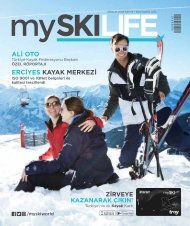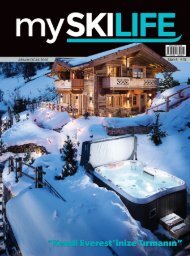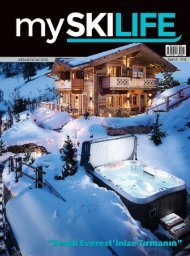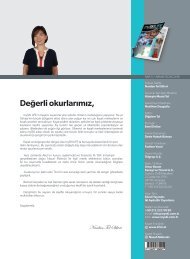You also want an ePaper? Increase the reach of your titles
YUMPU automatically turns print PDFs into web optimized ePapers that Google loves.
Ünye Kalesi<br />
Ünye merkeze 7 km mesafededir.<br />
Asfalt yolla ulaşım sağlanmaktadır.<br />
İlimiz Ünye ilçesinde Ünye - Niksar<br />
karayolunun 7. kilometresinde yolun<br />
solunda kalan bir tepenin üzerinde<br />
kurulu, ilçenin 5 km. güney doğusunda,<br />
2500 yıllık bir kaledir. Kale köyü sınırları<br />
içindedir. Yalçın dik yamaçlar üzerine<br />
kurulan duvarlar ve sütreler hala yeniliğini<br />
korumakta olup turistlerin ilgisini<br />
çekmektedir. Kale çok yüksek olduğu<br />
için XI - XII. yüzyıllarda müstahkem mevki<br />
olarak kullanılmıştır.<br />
Kapısı 5 m yüksekliğinde olup,<br />
incelemeler bu kapının II. Midridat<br />
zamanında yapıldığı ihtimalini<br />
kuvvetlendirmektedir. Kale girişi<br />
güneydoğudadır. Bu cephede yerden<br />
on metre yüksekliğinde, genişliği 3<br />
metre, yüksekliği 2 metre olan bir<br />
kaya mezarı bulunmaktadır. Mezarın<br />
üçgen kalınlığının her üç noktasında<br />
birer kabartma kartal bulunmaktadır,<br />
sağ uçtaki kabartma iyi korunmuş<br />
durumdadır. Zirveye yakın bölgede 45<br />
derece meyille kuzeybatı yönünde iki<br />
adet dehliz ve bir sarnıç bulunmaktadır.<br />
Unye Castle<br />
It is 7 km away from Unye centre.<br />
Transportation is made via an asphalt<br />
road. The castle was established on<br />
a hill which is 7 km away from Unye-<br />
Niksar highway; on the left side of the<br />
highway, and 5km in the south-east<br />
of Ünye District. It has been there for<br />
2500 years. The castle is within the<br />
borders of Kalekoy Village. Its walls<br />
established over steep slopes and<br />
crests which have been kept new,<br />
attracting tourists’ attention. The castle<br />
was used as a stronghold in the XI-XII<br />
centuries because of its height. Its gate<br />
was 5 m high and analyzes corroborate<br />
the possibility that this gate was made<br />
during the period of Midridat II. The<br />
entrance of the castle is in the southeast.<br />
At this side, there is a sepulchre<br />
which is 10 metres from the ground,<br />
3 metres wide and 2 metres high. At<br />
the three points of the triangle shaped<br />
sepulchre; there is an embossed eagle<br />
at each point. The embossed part on<br />
the right is well-protected. Near the<br />
peak of the castle, with 45 degrees<br />
inclination northwestwardly there are<br />
two tunnels, and a cistern.<br />
Ordu Paşaoğlu Konağı<br />
Etnoğrafya Müzesi<br />
Ordu Müzesi, il merkezinde,<br />
Selimiye Mahallesi, Taşocak Caddesi<br />
üzerinde yer almaktadır. “Paşaoğlu<br />
Konağı” adı ile anılan bina birinci sınıf<br />
bir sivil mimarlık örneğidir. Ordu’nun<br />
zengin eşraflarından Paşaoğlu Hüseyin<br />
Efendi diye bilinen şahıs tarafından<br />
1896 yılında yaptırılmıştır. Bahçesiyle<br />
birlikte 625 m²’lik bir alanı kapsayan<br />
bu konağın taşları Ünye’den, ahşap<br />
ve çini malzemeleri Romanya’dan<br />
getirilmiştir. Yapımında İstanbullu<br />
ustalar çalıştırılmıştır. 19. yüzyıl sivil<br />
mimarimizin en güzel örneklerinden biri<br />
olan Paşaoğlu Konağı zemin dâhil olmak<br />
üzere üç katlıdır. Zemin katı idare, birinci<br />
katı etnografik eserler bölümü, ikinci katı<br />
ise konak özelliklerini taşıyacak şekilde<br />
düzenlenmiştir. Paşaoğlu Konağı, Kültür<br />
ve Turizm Bakanlığı, Eski Eserler ve<br />
Müzeler Genel Müdürlüğü tarafından<br />
1982 yılında kamulaştırıldıktan sonra,<br />
1983 tarihinden itibaren onarılmaya<br />
başlanmıştır. Onarımı ve teşhir tanzimi<br />
tamamlanarak 18 Kasım 1987’de<br />
Paşaoğlu Konağı ve Etnografya<br />
Müzesi olarak hizmete açılmıştır.<br />
Ordu Paşaoğlu Konağı’nın onarılması<br />
ve müze olarak ziyarete açılması ile<br />
Karadeniz Bölgesi’nde bulunan ve<br />
geçen yüzyıldan zamanımıza ulaşan sivil<br />
mimarimizin ender örneklerinden biri<br />
daha gelecek nesillere bırakılmak üzere<br />
değerlendirilmiş bulunmaktadır<br />
Ordu Pasaoglu Mansion<br />
Etnography Museum<br />
Ordu Museum is in Selimiye<br />
Neighbourhood on Taşocak Street in<br />
the city centre. It is named as ‘Paşaoğlu<br />
Konağı’ which is an example of first class<br />
civil architecture.It was built in 1896 by a<br />
notable person of Ordu called Pasaoglu<br />
Huseyin Efendi. It is 625 m2 including<br />
the garden; the stones of this mansion<br />
were brought from Unye and wood<br />
materials and the ceramics were brought<br />
from Romania. The constructors from<br />
Istanbul built it. Paşaoglu Konagi is one<br />
of the most beautiful examples of civil<br />
architecture of the 19th century. It has<br />
three floors including the basement.<br />
The each floor was arranged for<br />
different purpose as the administration<br />
is on the basement floor, the first floor is<br />
the part of ethnographic works and the<br />
second floor carries the features of the<br />
mansion. The mansion was publicised<br />
in 1982 by the Ministry of Culture and<br />
Tourism, general Directorate of Ancient<br />
Arts and Museum which was began to<br />
be restored in 1983. The restoration and<br />
merchandising were completed on 18<br />
November 1987. It was put into service<br />
as Pasaoglu Konagi and Ethnography<br />
Museum. In this way, with the restoration<br />
of Pasaoglu Konagı and the opening<br />
of Ethnography Museum; one of our<br />
unique examples of civil architecture<br />
from the last century to the present time<br />
has been put to good use as a heritage<br />
to be left to our next generations.<br />
EYLÜL/EKİM 2015<br />
EYLÜL/EKİM 2015<br />
68 SEPTEMBER/OCTOBER 2015 SEPTEMBER/OCTOBER 2015<br />
69











